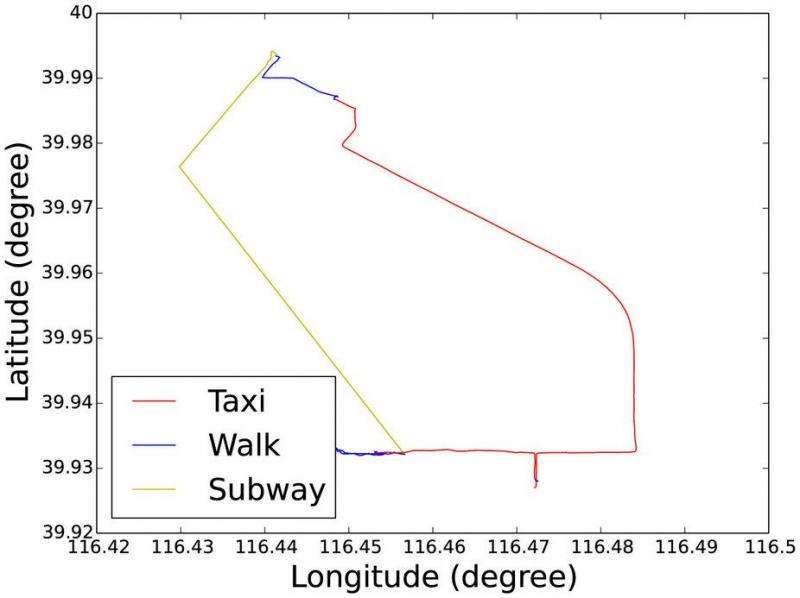Example of a synthetic trail for one day with taxi, walk, subway, walk, taxi, and walk sequence
Computer scientists studied human mobility in urban areas from the point of view that mobility can be described as random walk with many short steps and fewer extremely long steps. Combining GPS data with information on transportation modes they model the average movement patterns of mobile users. Understanding of human mobility is important not just for, e.g., tracking epidemic diseases but also in planning sustainable urban areas with functional data resources.
Human mobility has been empirically observed to exhibit Lévy flight characteristics and behaviour with power-law distributed jump size. The fundamental mechanisms behind this behaviour had not been fully explained so far. A group of computer scientists now analyzed urban human mobility and explain the Lévy walk behaviour observed in human mobility patterns by decomposing them into different classes according to the different transportation modes, such as Walk/Run, Bicycle, Train/Subway or Car/Taxi/Bus.
They show that human mobility can be modelled as a mixture of different transportation modes, and that these single movement patterns can be approximated by a lognormal distribution rather than a power-law distribution.
According to the scientists, previous research exploring the human mobility and examining taxi traces in one city in Sweden suggests that it might be the underlying road network that governs the Lévy flight human mobility. To verify that hypothesis, the present writers used a road network dataset of Beijing containing 433,391 roads with 171,504 conjunctions and plot the road length distribution. They show the road length distribution is very different to their power-law fit in flights distribution regardless of transportation modes.
"Thus the underlying street network cannot fully explain the Lévy flight in human mobility. This is mainly because of the fact that it does not consider many long flights caused by metro or train, and people do not always turn even if they arrive at a conjunction of a road. Thus the flight length tails in the human mobility should be much larger than those in the road networks", Professor Sasu Tarkoma from the University of Helsinki explains.
The key result of the article pertains to explaining the fundamental mechanism behind the Lévy flight characteristics of human mobility. Researchers showed that human mobility can be modelled as a mixture of different transportation modes. The result was empirically validated with two large real-life datasets containing ten to twenty million GPS samples from Beijing, China and Geneva, Switzerland.
The importance of the work lies in the future since exact mobility models are needed for understanding of human mobility not just for, e.g., tracking epidemic diseases but also in planning sustainable urban areas with functional data resources.
More information: "Explaining the power-law distribution of human mobility through transportation modality decomposition," Scientific Reports 5, Article number: 9136 (2015), DOI: 10.1038/srep09136
Journal information: Scientific Reports
Provided by University of Helsinki






















